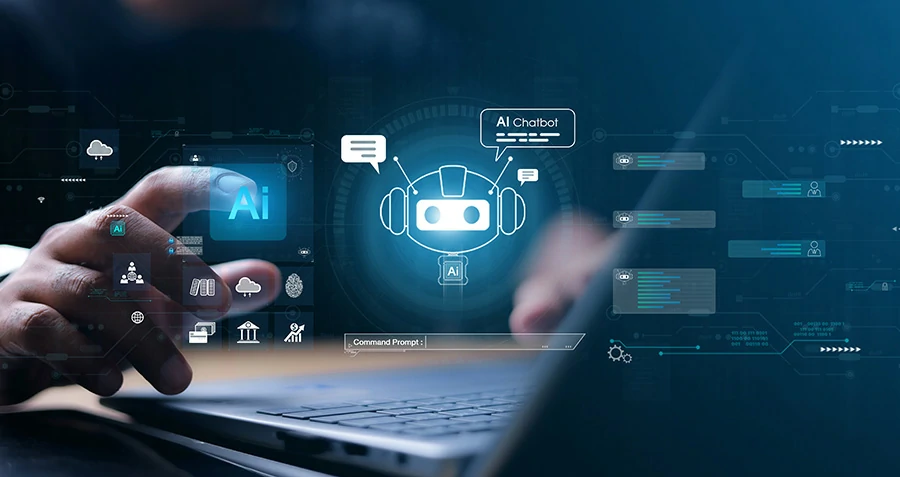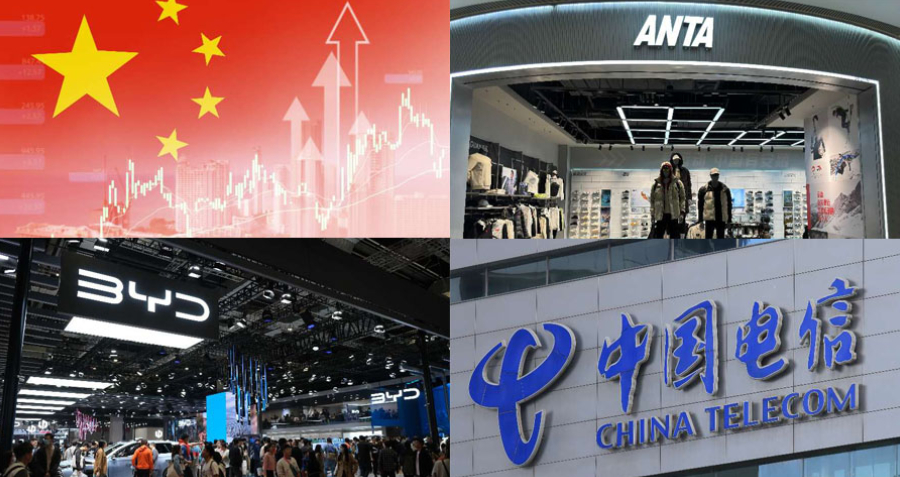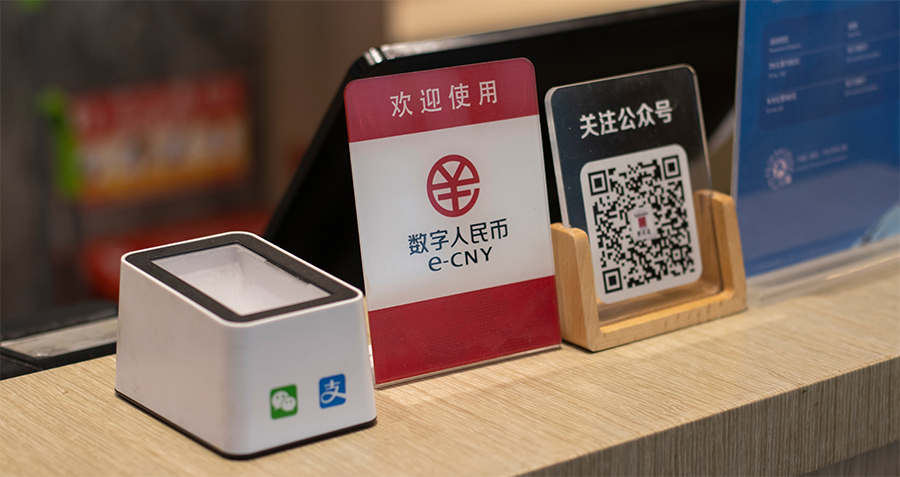The Chinese State Council recently issued an opinion on the in-depth implementation of the new policy goal, Artificial Intelligence+ (AI+), which requires the integration of AI across six key areas by 2027, and a penetration rate of more than 70% for smart terminals and AI agents.
In this interview, Sun Tianshu, Dean’s Distinguished Chair Professor of Information Systems at CKGSB, discusses the development of AI+, the cognitive gap in industry caused by a lack of AI architecture thinking and the need for businesses to choose the right scenario when integrating AI into their operations.
The deeper logic of the “AI+” policy
Q. At this point in time, what do you see as the key considerations of the government in launching the AI+ strategy?
A. I think it was very timely to launch AI+ in August 2025, and I think it is relevant to all businesses on three levels.
Firstly, the essence of AI is an intelligent revolution, and as we find ourselves at the start of what can be referred to as the “second half of AI,” we are seeing AI begin to reconfigure thousands of industries. The most striking feature of this phase is that intelligence itself is no longer a scarce resource with the open-sourcing of models, the explosion in the number of AI models and the rapid decline in costs. The real choke point has shifted from the technology itself to application in industrial scenarios, and how to utilize the ubiquitous AIs to reconfigure these scenarios and create real business value.
Therefore, the launch of the policy matches the intrinsic rhythm of the development of AI technology, and guides the focus of social attention from digital industrialization—including basic models, arithmetic power and chips—to industrial digitization, i.e., the application of vertical scenarios across industries.
Secondly, AI+ is an inevitable process in which both industry and AI help push development forward together. From the industry side, traditional industries are in urgent need of new growth engines and new quality productivity, and AI is the core driving force that seems to have the best chance to fulfill this role. From the AI technology end, the development of technology cannot be reliant upon just itself: it needs to have a continuous source of value and resource injection. The rich scenarios and complex business problems across thousands of industries provide the most fertile soil for the iterative and sustainable development of AI. Without the creation of industrial value, it is difficult for companies to continue to invest in AI, and in turn it is difficult for AI technology to rapidly iterate and continue to advance.
In China, we cannot rely solely on huge capital investment to drive AI development as in the US. China now has the largest industrial base in the world and that is our biggest comparative advantage. And only by developing and deploying AI across thousands of industries can the technology create value and form a positive cycle of AI input and output.
Third, the top-down policy push has an important role in education and helping AI gain traction. I have recently done a lot of research in the industry, and one of my main findings is that most entrepreneurs have not yet fully realized the nature of this AI revolution and the depth and breadth of the industrial restructuring that will be caused by AI. From my observations, the biggest problem in most businesses today is that they are only looking to solve today’s problems: no one is architecting tomorrow’s scenarios, much less imagining the business of the day after tomorrow. Many people are still using the industry’s habitual thinking or Internet+ mindsets to understand AI+, or are still pursuing small-scale and quick functional applications. This approach does not come from an AI native way of thinking when approaching how to design business scenarios, business models and organizational structure.
Therefore, there is a need for a top-down policy driver, something akin to KPIs, to push companies to think and plan at a deeper level. This wave of change is fundamentally different from the Internet+ era, which was more of a change in channels and links and was relatively intuitive and easy for enterprises to understand and establish independent development teams.
While AI+ does represent changes in AI architecture, it is also more abstract, and enterprises need to recursively use AI to structure their own development models considering the fundamentals of how to create value with a new form of intelligence. Although the perception of the modern enterprise is beginning to change, there will be an even greater shift in business scenarios, business models, organizational processes and ecological synergies.
Q. How much progress towards AI+ has China made so far and what are the bottlenecks and opportunities for enterprises to invest in AI?
A. AI+ has just begun, and all companies are on the same starting line in this second half of AI.
From an industry perspective, we are at a turning point. In the past, people paid more attention to digital industrialization, such as the development of basic models, arithmetic power and chips. Now, the focus is shifting to the vertical scenarios and business applications. It’s a fresh start, allowing all businesses the opportunity to rethink, plan and lay out.
The development of AI is happening much faster than industry can absorb, and the future possibilities for industry that stem from AI will have a significantly larger impact than any value gained thus far. Even if all AI tech development stops today, just using existing smart technology will be enough to bring about a massive change and reconfiguration to all industries for many years to come. There is a huge gap in the perception of AI between those in industry and the technology itself.
The root of this cognitive gap lies in the presence, or lack, of an AI architectural mindset in core decision makers. Intelligence is no longer scarce; what’s missing is the ability to architect it. This AI architectural capability is not about detailed knowledge of specific technologies, but a way of thinking about using intelligence to reconfigure business scenarios.
In order to imagine the future and how AI can change their own business scenarios and industry chain, a top entrepreneur must be able to go beyond the application of a single piece of technology. Rather they need to combine it with their knowledge of industry and insights into the nature of demand. If this change in perception does not happen, companies and perhaps even industries as a whole could come to a standstill in the second half of AI.
The core variable in this AI+ wave is ultimately people. Every industry needs a new generation of AI business architects. These people may be traditional entrepreneurs who have had their own cognitive breakthroughs, or they may be young people with an understanding of the industry and native knowledge and habits related to AI.
Q. The new policy sets three key time frames for AI+, namely 2027, 2030 and 2035, using penetration rate as a quantitative measurement. How should companies view each of these goals and measurements to guide and assess their AI progress?
A. I have a different view on how the AI+ revolution should be measured and evaluated. This wave cannot be measured in the same way that previous digital revolutions (e.g., IT, cloud computing, Internet apps) were measured. The biggest difference is that this AI revolution is centered on intelligence itself, not just digital tools or specific technologies.
In past IT systems, no matter how powerful the system, the ultimate decision-maker was still the user, and users are the only form of intelligence within the entire process. But the essence of the AI revolution is that the AIs themselves are intelligent and have the potential to make decisions by themselves, forming a closed loop of execution and feedback. This means that AI is no longer a discrete tool that can be simply quantified (e.g., whether the enterprise is using a certain system or app), and intelligence will penetrate and integrate into all aspects of decision-making in business scenarios akin to electricity in a house, giving rise to innovations and reconfigurations with impacts similar to Ford’s assembly line, and thus producing great value.
Therefore, I believe that the popularity of AI intelligence should be measured by scenario and by value: to what extent AI has empowered or even replaced the intelligence required for decision-making in how many scenarios in an industry or enterprise, thus changing the business model and creating value.
I don’t think that using an indicator such as application penetration, defined in the traditional way, will provide as accurate a measurement in this new era. The future of intelligence will be more integrated. For example, on a smart production line, you cannot distinguish between humanoid robots, robotic arms and software systems in the final product, rather it is a combination of all three. Or, for enterprises, there may be no change in outputs, but underneath, entire systems may have been reconfigured using multiple cooperating applications of AI. In these cases, defining and measuring penetration is difficult and in itself a new challenge for both academia and industry.
In industries related to digital industrialization, model iteration and Token—units of data processed by AI models—consumption can be used as indicators to represent the use of AI; however, the popularization of AI+ applications across thousands of industries must be measured by the number of scenarios transformed by AI.
How many core business scenarios within an enterprise already enable a closed value loop, from generating demand insights to organizing the provision of products? As more and more companies find their own benchmarking scenarios, new industry standards and more specific ways of measuring them will evolve. For example, the short-video content that is so popular is a typical example of an AI-driven scenario that meets users’ personalized needs without requiring massive business input. The key to enterprise transformation is to find such scenarios that can be reconfigured in an intelligent and native way.
Of course, the core intention of the policy in setting a target of over 70% penetration rate by 2027 is to encourage all enterprises to accelerate their efforts in this direction. But we must recognize that this is only a process indicator that serves the ultimate goal of economic growth. The fundamental goal is to encourage enterprises to use AI to pursue their own next-generation scenarios, create new demand and products, reshape their organization and ultimately transform the wider industrial model.
“Develop AI, then let AI develop you”
Q. The MIT NANDA report found that 95% of organizations are not yet getting value from their AI investments. In your view, what are the root causes of this phenomenon?
A. The root cause is that most enterprises have not really thought clearly about how to choose the most suitable scenarios for AI reconfiguration related to their core business, how to properly integrate AI in these scenarios, and how to use AI to structure the next-generation business models and organizational forms.
I’ll use an educational example to illustrate. Whether you are a college student or an entrepreneur coming to class, the impetus is to solve issues that relate specifically to you and at the same time develop as a person. The issue is that the education models of the past millennia have been limited by supply, with good teachers a scarce resource. As such we have become used to education being presented in the classroom, with groups of students.
But today, with intelligence no longer scarce, we can completely reconfigure this service model. An AI can serve every student with a clear understanding of their demand profile and business problems, and then combine it with the teacher’s knowledge base and best industry practices to provide personalized, high-frequency communication and learning.
In the future, we may see a scenario where each student still listens to the same teacher at the same time, but what each person hears may be completely different, tailored to their industry and the specific issues they are looking to solve. In the process, the value of the teacher’s time is magnified hundreds or thousands of times, and the needs of the students are more fully met.
As you can see from this example, the point of this change is not that the teacher is using a particular AI tool, but that the supply and demand model of the entire industry and scenario has been reconfigured. For this to happen, someone needs to be able to fully understand the nature of the requirements, imagine future scenarios and create new workflows with AI.
Therefore, for an enterprise, it is imperative to find one or two of the most core and value-embodying scenarios among the thousands of business segments, and build them into a closed-loop business benchmark driven by AI as the crux.
In short, we need to “develop AI, then let AI develop you.” The first stage requires providing data, tools, permissions and workflows for AI to grow within a scenario, and the second requires letting this intelligent actor drive the scenario’s efficiency and value to iterate and run faster. This process of choosing scenarios and architecting intelligence is much more important than starting projects blindly.
Q. Given that not all scenarios are suitable for all enterprises, how should enterprises determine whether they are the right fit for AI+? How can we find the native scenarios that are actually suitable to be reconfigured by AI?
A. To determine whether an enterprise is suitable, or to determine whether a business scenario is suitable for AI reconfiguration, I have a very simple but direct “million employee problem” litmus test.
If you suddenly had a million more intelligent employees in your organization or in a specific scenario that were tireless, had superior memories and were still learning, would you be able to satisfy your users better, faster and more completely? If the answer is yes, then there is a huge opportunity for AI reconfiguration in this scenario. If the answer is no, it means that the scenario is not suitable enough for the application of intelligence, and any investment is unlikely to bring about a significant increase in revenue.
So, not all businesses are suitable for AI reconfiguration, and many scenarios are not necessarily suitable for AI investment. Choice is greater than effort, and finding the scenario suitable for intelligent reconfiguration is the most important factor for an enterprise in the AI+ era.
The technological revolution is never fair; you can think of it as a mysterious force coming from an alien planet, and not everyone will be lucky enough to feel its impact. Similarly, if the current area of focus lacks opportunities, a top entrepreneur should realize that it is time to shift to another area. Having the courage and determination to adapt and embrace AI is more important than clinging to historical baggage and sunk costs.
As for how to identify these scenarios, I have a more specific methodology, summarized as “Three Mores, One Higher and One More Complex:”
- Three mores: More employees (or more repetitive human labor); More users/customers; and More expenses.
- One high: High-frequency interaction.
- One complexity: Requires complex knowledge and judgment.
Scenarios that fulfill these three characteristics are usually where AI can be of great value. The hardest part, however, is to understand the nature of an industry’s needs, and to go beyond today’s needs to imagine and create the needs of the next generation. This needs to be co-architected by people who understand the future, the industry and intelligence.
Intelligence is the greatest lever of the age
Q. Which companies or organizations stand to make the most of the major opportunities available in AI+?
Up until today, most of the value from AI has been extracted by larger players. But in the AI+ era, I think smaller or individual entrepreneurs will have a lot of opportunities, because AI+ is not a consumer-facing process, nor is it scaling of existing technological bases, but rather the reconfiguration of existing scenarios across industries.
In terms of consumer-facing development, it is difficult for startups to compete with the giant tech platforms, and it is difficult to change the existing competitive landscape in the short term. In the consumer-focused startup track, it is still a battle between the super-rich, who already own and control the data within most existing scenarios.
But for AI+ in industry, I think there is a huge opportunity for entrepreneurs. Because there is not the same existing scale effect, network effect or cost effect as there is on the consumer side, there will be many new opportunities for industrial reconfiguration.
Two important trends can be seen from today’s battle in the consumer services sector: Super Portals + Super AI.
So-called super portals refer to the further aggregation of users’ time and spending share through a small number of platforms. In the future, eating, drinking, food, clothing, housing, transportation, socializing and knowledge acquisition will all be amalgamated into a closed loop system on a very small number of applications.
The super portal aggregation represented in the consumer sphere will further empower and amplify Super AI, because the scenarios and available data are both richer and within a closed loop. As a result, the AI can be better embedded, iterated and educated, resulting in the evolution of the AI. There are still some vertical and emotional needs not met, meaning that there are entrepreneurial opportunities, but competition will still be a battle of the super-rich, existing tech giants.
For AI-native startups, there are two major advantages ahead:
- For one thing, native thinking, without the limitations of established rules or organizational structures, can structure human-machine collaborative workflows and AI-native business models around the capabilities of AI from day one, which can be directly aimed at meeting customer needs, thus providing brand-new opportunities.
- Second, without a large amount of core historical assets, there is no chance that these can end up as liabilities by the arrival of AI. The challenge for many industry leaders is that the core assets that they used to be proud of are gradually turning into baggage. Take digital cameras, for example, which have quickly turned Kodak’s film, global processing plants, distribution channels and retail outlets from an advantage into a burden.
Today, the widespread emergence and ubiquity of AI is changing the way industries work—organizations can be reconfigured in a more AI-native way, around dynamic iterative intelligence. The core opportunity for AI-native entrepreneurship is to turn the core assets of existing industry leaders into their core liabilities and leapfrog them.
The leverage an individual has in business today is much greater than ever before, and that is thanks to AI agents. In the past, growing a business had to rely on scaling by talent leverage, product leverage and capital leverage, but today there is a new leverage, that of intelligentsia (scaling by AI agents): intelligence is everywhere, and one person can architect a large number of AI agents to satisfy demand, reconfigure business and reshape scenarios.
Therefore, in the future, there will be an extremely high return on investment and fast growth entrepreneurship: no longer just 1x, 2x, 3x returns, but entrepreneurship and businesses with 100x and 1,000x leverage. Most people have not yet adapted to this new approach, much less been able to master it.
For current industry leaders, their biggest advantage lies in scenario assets and data built up over long-term operation. It is because of these factors that AI can be seamlessly integrated into them without having to create scenarios from scratch, and this has resulted in the AI receiving a large amount of data and support. Data assets in this case should be understood in a broad sense: they include both structured and unstructured “tangible data” about customer needs, production environments, retail channels, etc., as well as the “intangible data” that is the experience and knowledge accumulated by employees and experts.
These are the key areas where major companies can defend themselves against the onslaught of AI-native companies. By using their existing scenario and data assets, and superimposing on them AI native thinking, there is an opportunity for these companies to take the helm in the second half of AI, transforming existing advantages into a moat for the next era of industry, and transforming potential liabilities into differentiated advantages and incremental value.
There is only one way for organizations to measure AI investment
Q. After choosing a scenario, enterprises need to invest real money to carry out AI reconfiguration. How should they measure the Return on Investment (ROI) when they may not see business value in the short term?
A. The ultimate and only way to measure AI investment is business value. Until this value appears, businesses will have to rely on faith. This may sound esoteric, but like entrepreneurship, it is essentially a judgment-based commitment.
However, faith is not the same as hope. One of the core competencies of an AI architect is the ability to accurately design intermediate metrics and business milestones that lead to business value. After selecting the right scenario, the most critical thing for an AI architect to do is to define these intermediate goals, and by doing so they will already be halfway to success, as it helps bring together the whole organization to work in a specific direction.
To give an example in pharmaceutical retailing, the ultimate goal of the business is to increase GMV and profit. But what is the entry point for AI transformation? Is it to enhance the full lifecycle value of individual customers or to empower pharmacies to open more locations? And if, for example, you were to choose the former, your intermediate metrics might break down into: improving customer visit frequency, improving in-store conversion rates, improving affiliate sales and customer unit prices, etc.
A good intermediate indicator must fulfill two conditions: first, it is a business indicator with clear and measurable value; second, it can become an indicator for the dynamic iteration of AI.
One example is TikTok’s user hours, which is a metric that serves both a business goal and can also be broken down into different quantitative elements, such as single-video stays, watch completion rates, and so on. These in turn can be used to guide iterations of the recommendation algorithm, e.g. when the algorithm realizes that it’s pushed content that a user only watched for a second before swiping away, it knows that the recommendation was a failure and that it needs to adjust its strategy.
This ability to translate business goals into data metrics and use them to push AI to iterate and form flywheels is at the heart of the AI architecture mindset. Once you have this iterative mechanism in place, you can leave the rest to the AI and trust the speed and potential of its iterations.
Q. Can you explain the concept of ‘AI native’ as mentioned in the AI+ initiative? How can we cultivate AI native thinking?
A. The idea of being AI native is to approach building businesses and organizations with AI at their core. These AI native enterprises can fully utilize the capabilities of AI agents across scenarios through cleverly structured business models and organizational synergies.
For example, TikTok and Didi—China’s Uber equivalent—are both mobile-native products and it is hard to imagine swiping through TikTok and using Didi during the PC era. It is almost impossible to consume and produce short video content without using cell phones as they provide both the camera for recording content and the ability to swipe up and down on the screen. It is also impossible to efficiently match users and drivers on ride-hailing apps without the sharing of real-time GPS locations.
To be properly AI native, the key is to think about how you can help the AI agent succeed in each scenario by coaching and guiding it until it can work on its own. As an example, we can imagine an AI agent as a new ‘geeky’ employee in an organization. That employee has an infinite memory, can quickly absorb and integrate massive amounts of knowledge, can invoke a variety of tools and interfaces, works 24/7, and has dynamic feedback and iterative ability to continuously learn and even expand. But at the same time they do not have some of the common abilities that ordinary people have, such as recognizing people’s intentions.
The AI native way of thinking is to understand and believe in this new “colleague’s” abilities and to think about how to maximize its potential through teaching knowledge, supplying data, equipping it with the correct tools and permissions and providing ongoing feedback and companionship. You need to genuinely want to see it succeed and want it to be at the center of the organization, rather than seeing it as a threat, worrying that it will steal your thunder, or wanting it to be completely accommodating and help you get things done within your existing work habits and organizational processes. As emphasized above, we need to learn to “develop AI, then let AI develop you.”
This AI native architecture thinking is exemplified in several ways:
- Experiment with the AI agents first, to gain an understanding of the boundaries of the AI agent’s abilities and understand its basic principles.
In the second half of AI, good entrepreneurs need to continuously develop their intuition through usage to understand the boundaries of the capabilities of AI agents, while great entrepreneurs also need to grasp the principles and essence of AI, how they operate and other technical principles. This way, we can also make more informed predictions as to where breakthroughs and innovations in AI will appear, allowing us to continuously define new business models, discover new scenarios and lay out paths to innovation using the evolution of AI.
- Designing human-machine collaborative processes
You need to think about how to equip this AI agent with human partners, or even as a supervisor to some human employees. You need to understand how to provide them with what they need to better integrate into the organization and perform their role effectively.
- Supporting mechanisms to help AI Agents continue to iterate
You need to understand the importance of a reward function and know how to design clear assessment goals and feedback iterations for AI employees so that the intelligence can continue to grow.
In today’s world, a lot of people understand business, but very few understand AI business. This is the ability to perfectly integrate the design of AI with the design of the business, and to do business in a way that is AI native. The ultimate goal is not to use AI for the sake of AI, but to use AI to creatively architect the next generation of business. That’s the essence of AI architectural thinking.
Industry calls for AI business architects
Q. You have repeatedly emphasized the importance of AI architects. Does that mean that talent is the biggest sticking point in promoting AI+? How should we cultivate such talents?
A. Yes, I think the biggest challenge and opportunity for AI+ today lies in talent, especially the next generation of AI architects who really understand industry, intelligence and the future. A true AI architect is worth an army of thousands.
I think there is a big problem with a systematic mismatch between traditional enterprises with scenarios and data, and external talents with AI architecture capabilities. People who own scenarios don’t have AI architectural capabilities, while people who have AI architectural capabilities don’t own scenarios, and they can’t find each other. So how can we go about creating a mechanism for cooperation, incubation, synergy and co-creation?
Regarding how to cultivate talent, my view is that AI architects must be developed through the reconfiguration of various industries rather than being a skill learned in school. Experience and trial and error is key to their development, and we need to create the conditions for those candidates to emerge.
I believe there are three core qualities that AI architects need to possess:
- Understand AI and have an AI architectural mindset. This doesn’t necessarily require programming, but it does require an intuitive understanding of what AI can and can’t do, as well as a qualitative understanding of how it works, and an interest in the evolution of AI. They also need the ability to determine how business scenarios are going to change and how they might be architected when your organization has a million more AI employees.
- Understand the industry and have in-depth insights. This requires a real deep dive into industry scenarios to understand the true nature of demand and the way in which industries such as energy, healthcare and manufacturing are organized. For young people, this is the most needed exercise and opportunity.
- Understand the future and have the courage to be original. Be bold enough to think outside the box and the logic inherent in the industry, think in terms of first principles, and imagine and architect the next generation of business. At the same time, it is important to have the ability to manage the pace of transformation and build new ways of working with people and machines.
The first two—knowledge of intelligence and knowledge of industry—can be nurtured. Developing an AI architect is much like developing an AI model; you have to provide them with scenarios, data and feedback mechanisms. What we want to do is to create an environment where young people with potential can train in industry, to complete the pre-training and fine-tuning of the parameters of the neural network in their brains.
Q. “People who own scenarios don’t own AI architectural capabilities, while people who own AI architectural capabilities don’t own scenarios, and they can’t find each other.” What can be done to improve this situation?
A. This is quite a profound but common problem, and also a big difference between AI+ and Internet+. To resolve this mismatch, we cannot rely solely on policy guidance but ultimately on market mechanics.
At the core, organizations, and especially CEOs, need to be good AI architects. This person not only architects the business, but also the organization and the talent. They need to have the ability and the intelligence to identify, discover and cultivate those who truly have the ability to architect intelligently and are willing to open up the scenarios, the data, the knowledge and the opportunities to practice to them. This talent is likely to come from outside the organization, and this is because there is not a lot of talent within traditional industries that directly possesses algorithmic thinking and the courage to be original.
This raises several practical questions: what is the salary structure and why would a top AI talent want to join an industry with relatively traditional pay and pace? Companies will be required to make bold innovations in organizational design and incentives, and to use a market-based approach so that top talent is willing and able to quickly enter various industries.
I think the current talent overflow in the Internet industry is a huge opportunity. I always say that the Internet is a small hill with millions of practitioners, while AI+ is a mountain that needs hundreds of millions of practitioners. There is a massive opportunity in working out how we can transfer those from the Internet to the AI+ era.
Summary
The essence of AI+ is not the replacement of existing tools, but in AI becoming the new core of industry. It is no longer the technology stack that determines success or failure, but the ability to architect intelligence across a thousand different scenarios. Whoever can take the lead in AI architecture thinking, find AI native scenarios, set up indicators and iterations, cultivate AI architects within those scenarios, and reconstruct the business model and organizational design with the leverage of AI agents, will truly be able to lead in the second half of the AI game and define the next generation of industry.
Condensed Summary of the Interview
- There is one fundamental difference between AI and all previous technologies across mankind’s history: AI is no longer a tool to assist humans, but an intelligence itself similar to humans. Intelligence in AI is no longer scarce, but what is scarce is the ability to design frameworks for and build that intelligence and create value in business scenarios. What is most lacking in the “AI+” industry are “AI architects”: talents who can integrate business scenarios and intelligence capabilities, and use AI to structure next-generation business forms, organizational designs and business models.
- Currently, there is a huge cognitive gap in the industry: the development of AI is happening much faster than industry can absorb, and the future possibilities for industry that stem from AI will have a significantly larger impact than any value gained thus far. The root cause of this AI cognitive gap lies in the lack of AI-related architectural thinking among entrepreneurs and decision makers in the industry, which prevents them from properly integrating intelligence into different business scenarios. Whoever can be the first to do this properly will emerge as a leader in this new era of AI+ and define the next generation of industry.
- AI reconfiguration is not right for all businesses. To quickly determine whether an enterprise or a scenario is suitable for AI reconfiguration, I use the million employee question—if a business suddenly has a million more intelligent employees with PhD-level expertise, can it significantly improve the business? If yes, then the enterprise or scenario is suitable for AI reconfiguration.
- Enterprise AI transformation and AI native incubation should be grasped with both hands: the core assets and core interests of some enterprises are at risk of becoming the baggage that drags them down in the AI era. Having the courage and determination to start from scratch and embrace AI is more important than clinging to the status quo.
- The success or failure of AI transformation depends on the choice of future scenario, and choosing the right scenario while building the right architecture is far more important than burying your head in the sand and simply remodeling. The fundamental reason why most enterprises’ AI attempts have not proved to produce value so far is not due to technical defects, but to the failure to choose the right scenario that can be the route to value creation.
- Finding the most suitable scenarios for AI reconfiguration requires a “three more, one higher and one more complex” approach. Scenarios with many employees/customers/expenses, high-frequency interactions and scenarios that require complex knowledge and judgment are all native scenarios that are most suitable for AI integration.
- Intelligent native thinking and the approach of “developing AI first, then let AI develop you”— Intelligent native enterprises need to “develop AI” first (i.e., provide knowledge, data, tools, permissions and collaborative workflows for AI, so that they can grow within a scenario). The AI will then “develop you” (i.e., letting this intelligent core drive the efficiency, feedback and value of the scenario to keep iterating and running faster). This process of being deliberate about scenario choices and architecting intelligence is key, rather than blindly starting projects.
- AI Agents’ levers are reshaping the opportunity landscape for startups and industrial companies: big players will monopolize the consumer-facing changes in the short term, creating super portals with super AI capabilities (an AI system that possesses cognitive capabilities that far exceed those of the most intelligent humans across a wide range of domains). Startups have the opportunity to reconfigure the industry on the enterprise side: using AI native thinking and asset-light investment to reconfigure the organization, with the biggest opportunity being to turn the core assets acquired by leading enterprises in the last era of AI into their core liabilities in the AI era. The moat of industrial enterprises lies in the accumulation of scenarios and data, and if superimposed with AI architecture thinking, there is a chance for them to become a rapidly developing second generation of AI players.























